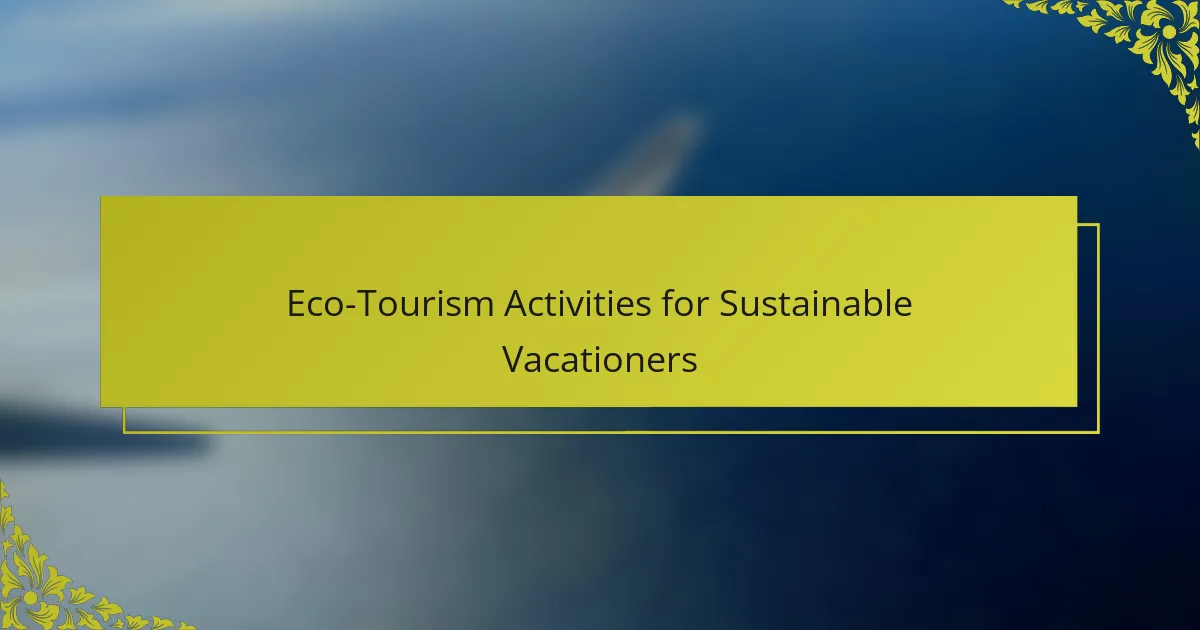Eco-tourism activities offer sustainable vacationers a way to enjoy travel while prioritizing environmental conservation and cultural respect. These activities include wildlife watching, hiking, and community-based tourism, promoting awareness and appreciation of local ecosystems. Challenges such as high costs and greenwashing can complicate eco-tourism choices, but informed decisions can enhance the travel experience and support local communities. By engaging in responsible practices, travelers can contribute positively to both the environment and the cultures they visit.
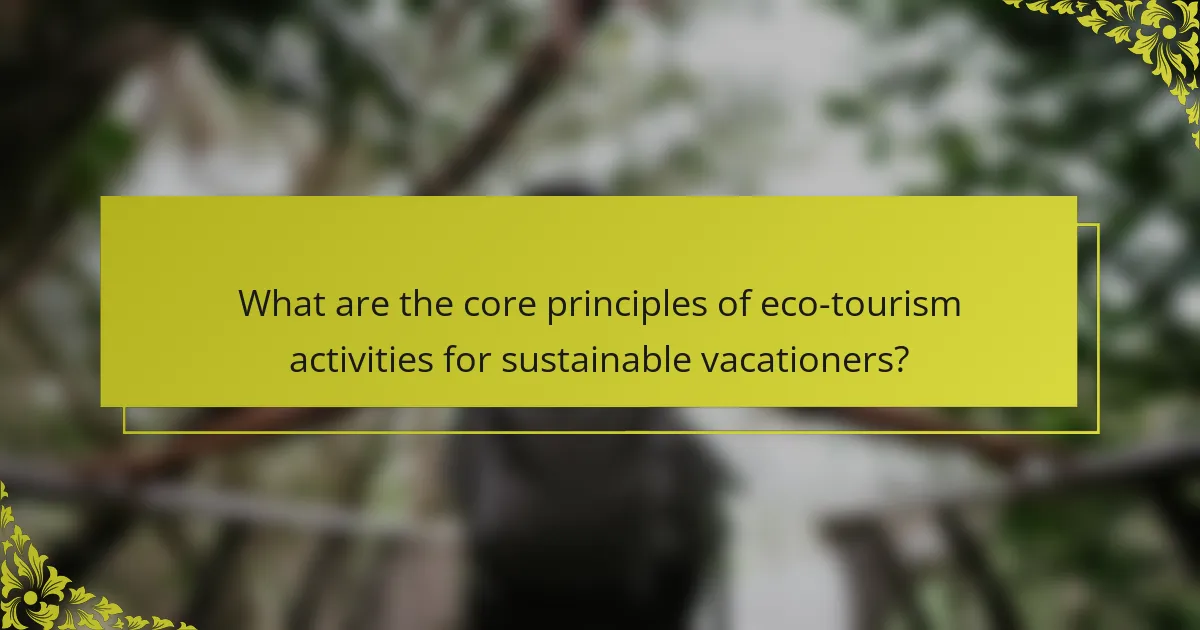
What are the core principles of eco-tourism activities for sustainable vacationers?
Eco-tourism activities prioritize environmental conservation and cultural respect, ensuring sustainable vacation experiences. Key principles include minimizing environmental impact, supporting local economies, and promoting education about natural habitats. These practices foster a deeper connection between travelers and destinations, enhancing the overall travel experience. Sustainable vacationers engage in responsible behaviors, such as choosing eco-friendly accommodations and participating in conservation projects, which contribute to preserving ecosystems. By adhering to these core principles, eco-tourism not only protects the environment but also enriches the lives of both visitors and local communities.
How do eco-tourism activities benefit local communities?
Eco-tourism activities benefit local communities by promoting economic growth, preserving natural resources, and fostering cultural exchange. These activities create jobs in hospitality, guiding, and conservation. They also encourage sustainable practices, which protect local ecosystems and enhance community pride. Additionally, eco-tourism often leads to infrastructure improvements, such as better roads and facilities, which can benefit residents.
What environmental impacts do eco-tourism activities aim to mitigate?
Eco-tourism activities aim to mitigate various environmental impacts, including habitat destruction, pollution, and biodiversity loss. These activities promote conservation efforts, support local communities, and encourage sustainable practices. For example, eco-tourism can reduce carbon footprints by prioritizing low-impact travel options. Additionally, it fosters awareness around protecting natural resources and ecosystems.

Which eco-tourism activities are most popular among sustainable vacationers?
Eco-tourism activities popular among sustainable vacationers include wildlife watching, hiking, and community-based tourism. These activities promote environmental conservation and cultural appreciation.
Wildlife watching allows travelers to observe animals in their natural habitats, fostering a connection to nature. Hiking offers immersive experiences in pristine landscapes, encouraging physical activity and environmental awareness. Community-based tourism supports local economies and cultural exchange, providing authentic experiences while ensuring sustainability.
Engaging in these activities not only enhances personal enjoyment but also contributes to the preservation of ecosystems and local cultures.
What types of eco-friendly accommodations are available for travelers?
Travelers can choose from various eco-friendly accommodations, including eco-lodges, glamping sites, sustainable hotels, hostels, treehouses, and farm stays. Eco-lodges often feature renewable energy sources and local materials. Glamping combines luxury with nature, providing comfort while minimizing environmental impact. Sustainable hotels prioritize green practices, such as water conservation and waste reduction. Hostels offer budget-friendly options with eco-conscious initiatives. Treehouses provide unique stays in natural settings, while farm stays allow guests to experience sustainable agriculture firsthand. Each type supports eco-tourism and promotes environmental awareness.
How can sustainable vacationers participate in wildlife conservation efforts?
Sustainable vacationers can engage in wildlife conservation through eco-tourism activities that support local ecosystems. Participating in guided wildlife tours helps raise awareness and funds for conservation projects. Volunteering for habitat restoration enables hands-on contributions to local environments. Supporting local businesses that prioritize sustainable practices fosters economic benefits for conservation efforts. Additionally, donating to wildlife protection organizations amplifies the impact of eco-tourism initiatives.
What role do cultural experiences play in eco-tourism activities?
Cultural experiences enhance eco-tourism activities by fostering deeper connections between travelers and local communities. These interactions promote understanding of local traditions and environmental practices, enriching the travel experience. Engaging with local customs can lead to sustainable practices that benefit both the environment and the economy. For instance, participating in traditional crafts or local cuisine can support artisans and farmers, reinforcing the value of cultural heritage in eco-tourism.
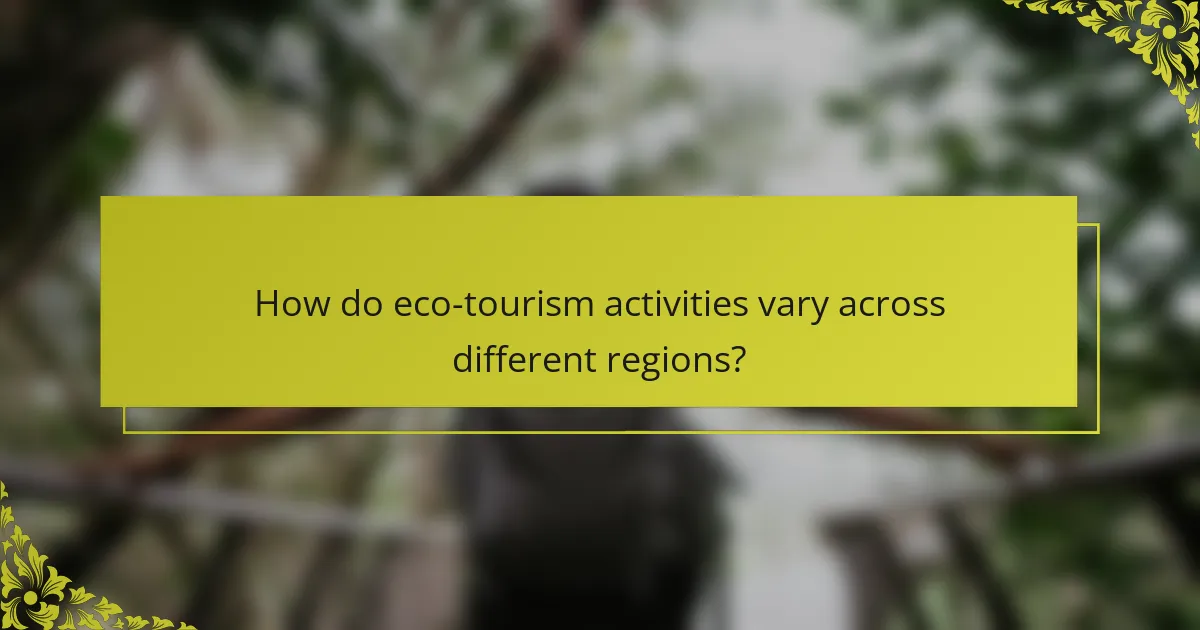
How do eco-tourism activities vary across different regions?
Eco-tourism activities vary significantly across regions due to local ecosystems and cultural practices. In tropical regions, activities like rainforest hikes and wildlife safaris are prevalent, promoting biodiversity awareness. Coastal areas often focus on marine conservation through snorkeling and eco-friendly boating. In mountainous regions, sustainable trekking and cultural exchanges with indigenous communities are common. Each region’s unique environmental characteristics shape its eco-tourism offerings, enhancing the sustainable vacation experience.
Which eco-tourism activities are unique to specific destinations?
Unique eco-tourism activities vary by destination, enhancing the travel experience. For example, Costa Rica offers canopy tours that allow visitors to explore rainforests from above, while the Galapagos Islands provide opportunities for close encounters with unique wildlife. In Thailand, community-based tourism lets travelers engage with local cultures through homestays and traditional crafts. Iceland features geothermal spa experiences that connect visitors to the natural landscape. Each activity emphasizes sustainability and cultural appreciation, making them distinct to their locations.
How does the perception of eco-tourism differ in various cultures?
The perception of eco-tourism varies significantly across cultures. In some cultures, eco-tourism is viewed as a vital approach to preserving nature and supporting local communities. For instance, in Scandinavian countries, eco-tourism emphasizes sustainability and environmental education. Conversely, in many developing nations, eco-tourism may be seen primarily as a means of economic development, prioritizing financial benefits over environmental concerns.
Cultural values shape these perceptions. In indigenous cultures, eco-tourism often aligns with traditional practices and spiritual connections to nature. In contrast, urbanized cultures may focus on recreational aspects, viewing eco-tourism as an escape from city life.
Furthermore, the success of eco-tourism initiatives often hinges on local engagement and respect for cultural heritage. Effective eco-tourism fosters a balance between conservation and community welfare, adapting to the unique values and expectations of each culture.
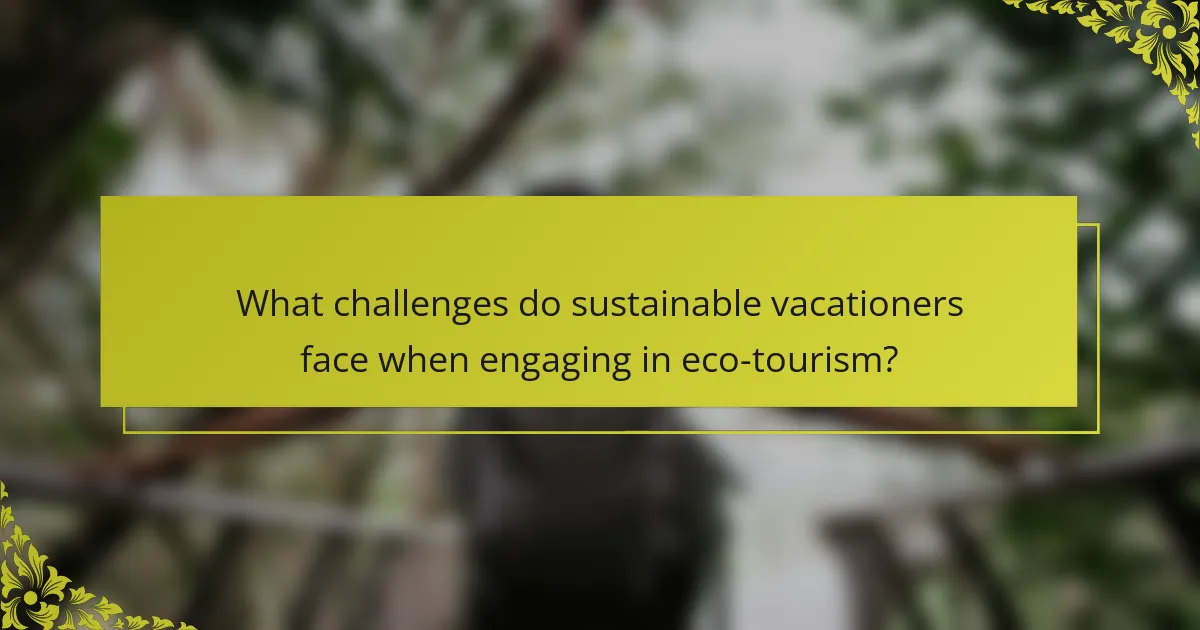
What challenges do sustainable vacationers face when engaging in eco-tourism?
Sustainable vacationers face challenges such as high costs, limited options, and potential greenwashing. These obstacles can deter eco-tourism participation. High costs often arise from premium pricing for eco-friendly accommodations and activities. Limited options may restrict access to authentic experiences in less-traveled areas. Greenwashing, where companies falsely claim eco-friendliness, complicates decision-making for travelers seeking genuine sustainable practices.
How can travelers overcome barriers to participating in eco-tourism activities?
Travelers can overcome barriers to participating in eco-tourism activities by prioritizing education, accessibility, and local engagement. Understanding the environmental impact and benefits of eco-tourism fosters enthusiasm. Accessible transportation and accommodations enhance participation. Collaborating with local communities enriches experiences and supports sustainable practices.
What are common misconceptions about eco-tourism?
Many misconceptions about eco-tourism persist, including the belief that it is always expensive or only for wealthy travelers. Eco-tourism can be affordable and accessible to various budgets. Another common myth is that eco-tourism is ineffective in promoting conservation. In reality, well-managed eco-tourism initiatives can significantly contribute to environmental protection and local community development. Some people think eco-tourism is only about wildlife experiences, but it also includes cultural immersion and sustainable practices. Lastly, many assume eco-tourism has no negative impacts, yet poorly planned eco-tourism can lead to environmental degradation.
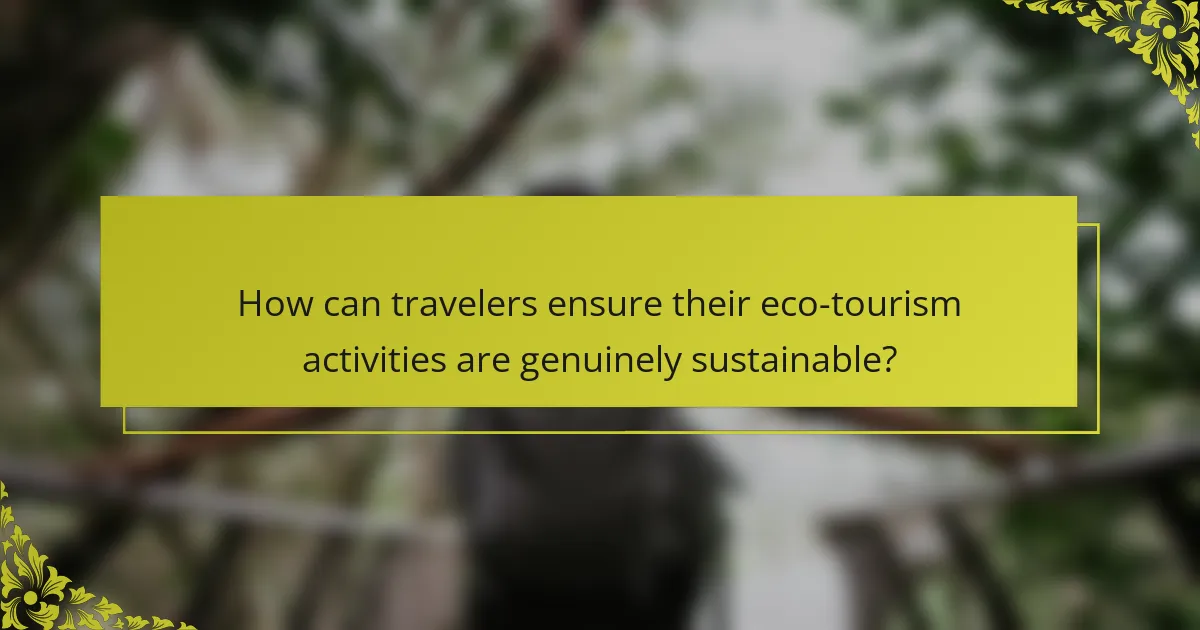
How can travelers ensure their eco-tourism activities are genuinely sustainable?
Travelers can ensure their eco-tourism activities are genuinely sustainable by choosing certified operators, supporting local communities, and minimizing their carbon footprint. Research operators’ sustainability practices and look for certifications like Green Globe or EarthCheck. Engage with local cultures and economies to ensure benefits remain within the community. Use public transport, walk, or cycle to reduce emissions during travel. Prioritize activities that conserve natural resources and protect wildlife. By making informed choices, travelers can contribute positively to the environment and local cultures.
Which certifications should vacationers look for in eco-tourism providers?
Vacationers should seek eco-tourism providers certified by recognized organizations. Look for certifications such as the Global Sustainable Tourism Council (GSTC), Rainforest Alliance, and EarthCheck. These certifications ensure adherence to sustainability standards and responsible practices. Additionally, check for local certifications that reflect regional environmental commitments. Selecting providers with these certifications promotes responsible travel and supports conservation efforts.
What best practices can enhance the eco-tourism experience?
To enhance the eco-tourism experience, travelers should engage in responsible activities that minimize environmental impact. Prioritizing local guides fosters cultural exchange and supports the community. Choosing eco-friendly accommodations reduces carbon footprints. Participating in conservation efforts, such as wildlife monitoring, helps preserve natural habitats. Finally, practicing Leave No Trace principles ensures that ecosystems remain undisturbed.
What are the most common mistakes to avoid in eco-tourism activities?
Common mistakes in eco-tourism include neglecting local cultures, not minimizing waste, and failing to respect wildlife. Sustainable vacationers should prioritize responsible practices to enhance their experiences.
1. Ignoring local customs and traditions can lead to cultural insensitivity.
2. Overlooking waste management contributes to environmental degradation.
3. Disturbing wildlife disrupts natural habitats and ecosystems.
4. Choosing unsustainable transportation increases carbon footprints.
5. Not supporting local economies limits community benefits.
6. Failing to educate oneself about eco-tourism principles undermines its purpose.
